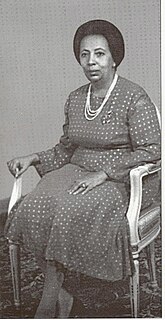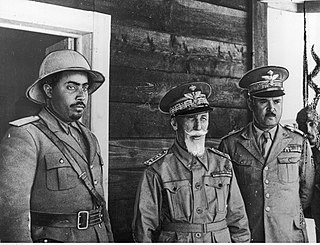Related Research Articles

Haile Selassie I was Emperor of Ethiopia from 1930 to 1974. Prior to his coronation, he had been the Regent Plenipotentiary of Ethiopia from 1916. He is a defining figure in modern Ethiopian history. He was a member of the Solomonic dynasty who traced his lineage to Emperor Menelik I.

Addis Ababa University (AAU) is a large, highly residential national university in Addis Ababa, Ethiopia. The university is the oldest school of higher education in Ethiopia. AAU has thirteen campuses. Twelve of these are situated in Addis Ababa, and one is located in Bishoftu, about 45 kilometres (28 mi) away. AAU has several associated research institutions including the Institute of Ethiopian Studies. The Ministry of Education admits qualified students to AAU based on their score on the Ethiopian University Entrance Examination (EUEE).

The Emperor of Ethiopia was the hereditary ruler of the Ethiopian Empire, until the abolition of the monarchy in 1975. The Emperor was the head of state and head of government, with ultimate executive, judicial and legislative power in that country. A National Geographic article called imperial Ethiopia "nominally a constitutional monarchy; in fact [it was] a benevolent autocracy".

The Derg, officially the Provisional Military Government of Socialist Ethiopia, was the military junta that ruled Ethiopia from 1974 to 1987, when the military leadership formally civilianized the administration but stayed in power until 1991.

Amha Selassie was Emperor-in-exile of Ethiopia. As son of Haile Selassie I, he was Crown Prince and was proclaimed Emperor three times. He was first proclaimed Emperor during an unsuccessful coup attempt against his father in December 1960, during which he was detained and compelled to accept the title. After his father was deposed in a later coup, he was proclaimed Emperor again in absentia by the Derg on 12 September 1974 in an act which he never accepted as legitimate and that ended in the abolition of the Ethiopian monarchy on 12 March 1975. He was again proclaimed Emperor in exile on 8 April 1989. This time he sanctioned the proclamation and accepted its legitimacy. After his accession, his full reign name was His Imperial Majesty Emperor Amha Selassie I, Elect of God, Conquering Lion of the Tribe of Judah and King of Kings of Ethiopia.

Princess Tenagnework Haile Selassie, DBE baptismal name Fikirte Mariam, of Ethiopia was the eldest child of Emperor Haile Selassie and Empress Menen Asfaw.

Abune Theophilos, also known as Abune Tewophilos, was the second Patriarch of the Ethiopian Orthodox Tewahedo Church. He officially succeeded Abuna Basilios in 1971 after he had assumed the role of acting patriarch upon Abuna Basilios's death in 1970.

The Crown Council of Ethiopia was the constitutional body within the Ethiopian Empire, which advised the reigning Emperor of Ethiopia. It also acted on behalf of the Crown. The council's members were appointed by the Emperor.
Princess Aida Desta, was the eldest granddaughter of Emperor Haile Selassie of Ethiopia, eldest child and daughter of Ras Desta Damtew and Princess Tenagnework. She was the wife of Leul Ras Mangasha Seyum, Prince of Tigray, son of Seyum Mangasha, and great-grandson of Emperor Yohannes IV. Her godmother was Empress Zewditu of Ethiopia.

Princess (Leult)Ijigayehu Amha Selassie was the eldest child of Crown Prince Asfaw Wossen of Ethiopia by his first wife, Princess Wolete Israel Seyoum and was the granddaughter to Emperor Haile Selassie.

The Ethiopian Air Force (ETAF) is the air force of Ethiopia, and the branch of Ethiopian National Defence Force. The force is tasked with protecting the national air space, providing support to ground forces, as well as assisting civil operations during national emergencies.

Leul Ras Imru Haile Selassie, CBE was an Ethiopian noble, soldier, and diplomat. He was also the cousin of Emperor Haile Selassie.

Haile Selassie Gugsa (1907–1985) was an army commander and a member of the Imperial family of the Ethiopian Empire from Tigray.
The following lists events that happened during 1974 in Ethiopia.

Lieutenant-General LijAbiye Abebe was an Ethiopian politician and son-in-law of Emperor Haile Selassie.

The Menelik Palace, also known as the Imperial Palace or Great Ghebbi, is a palatial compound in Addis Ababa, Ethiopia. Previously for years was known as the Gebi, it was the seat of the power of Ethiopia's emperors. Within its confines are several residences, halls, chapels, and working buildings. Today it contains the offices and residence of the Prime Minister of Ethiopia.

The Guenete Leul Palace is a palace in Addis Ababa, Ethiopia. It was built by Emperor Haile Selassie in 1930. The Emperor and his family made the palace their main residence, but the seat of government remained at the Imperial Palace.
Orders, decorations, and medals of Ethiopia are awards of the government of Ethiopia which are typically issued for sustained meritorious service, whether it be in a civilian capacity or in their capacity in the Ethiopian National Defense Force. They are governed by the laws of Ethiopia on awards.

The Tiglachin Monument, sometimes called Derg Monument, is a memorial to Ethiopian and Cuban soldiers involved in the Ogaden War. It was built during the rule of Mengistu Haile Mariam and is located on the Churchill Avenue in Addis Ababa, Ethiopia. The monument is composed of various elements: a central statue, a 50 m tall pillar, two wall reliefs on the sides and two squares where the portraits of Cuban soldiers are visible. Some sculptures at the monument was given by the North Korean government in 1984, and was one of the project’s first monuments to be donated to Africa.
References
- ↑ https://www.capitalethiopia.com/capital/afd-provides-assistance-for-the-national-palace-renovation/.Missing or empty
|title=(help) - ↑ https://www.thereporterethiopia.com/article/president-sahlework-pm-abiy-share-palace-compound?__cf_chl_jschl_tk__=7b88664b05efc59bdc919e51b5406055bf48946c-1624542682-0-ASCjYAQJSsHLeSuqpNKLd6lxJi4mBVbN1r53YGSDhL2FYiaSvpB4MqyIUfoE0QhldsdevI-Zc9eSip9fpj_2K3lNfHxrqpOtHGSX99wbhiAxn7dcwzDSlwfofomFiySZ05DX1DVNRRcu9jtUCXU6hgZP3x9eLiGN10ZGtbmrNLK32XZXuhNdLtGHLjUGseXLP-2Pp30bvKb08xrky6w5T0I4fD0kY8UumoVA3WPv9HVWK3DPwKuD1L9BVrkg3vgPtkgsekaYnSZ4NKC5SXOlzgLNUm0kd-9k8eTnKQQQRWSt2mj3cKnfIv3MVTeCSmsoKAxxgPuzqUfTru1IJez5VXafLhIriYQHXGUOtDd2wQKhK8lgvI5LQu2Lcn8QbIqgvHcLkYa3c8-_vwRktX7XUyfi_ENS3r5_apKNaBNsWvxdCZoLGT9C703zTagNzd_rbNKw5U-Njyk8nI3n-mEKY7EYazBVJ99AMsTNHga2t5FY.Missing or empty
|title=(help) - ↑ "National Jubilee Palace to open doors for visitors – Ethiosports" . Retrieved 2021-06-24.
- ↑ https://www.washingtonpost.com/world/africa/a-place-of-ghosts-ethiopia-opens-controversial-palace-to-a-divided-public/2019/10/11/4ddd2d9c-ead5-11e9-a329-7378fbfa1b63_story.html.Missing or empty
|title=(help)